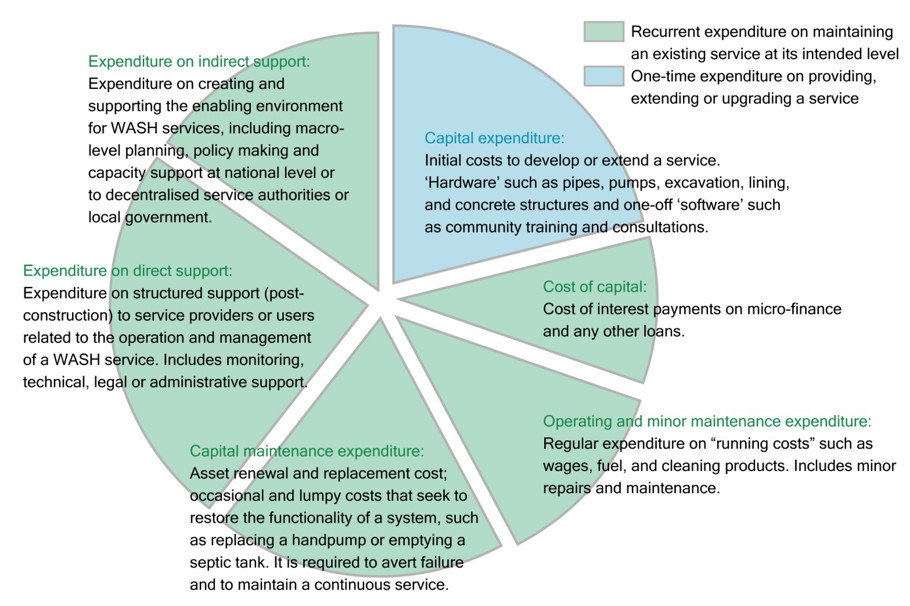Difference between revisions of "Costs of WASH Service Delivery - Introduction"
| Line 1: | Line 1: | ||
__NOTOC__ | __NOTOC__ | ||
| + | [[Image:Costs of WASH icon.png|right|100px|]] | ||
The costs of water, sanitation and hygiene services include expenditure on construction of water and sanitation systems, operation and maintenance and eventual rehabilitation of infrastructure. It also includes training and support to service providers, cost of capital, and expenditures for monitoring, planning and policy making. They are often referred to as life-cycle costs; the costs of delivering water, sanitation and hygiene services indefinitely to a specific population in a particular geographic area. | The costs of water, sanitation and hygiene services include expenditure on construction of water and sanitation systems, operation and maintenance and eventual rehabilitation of infrastructure. It also includes training and support to service providers, cost of capital, and expenditures for monitoring, planning and policy making. They are often referred to as life-cycle costs; the costs of delivering water, sanitation and hygiene services indefinitely to a specific population in a particular geographic area. | ||
| Line 6: | Line 7: | ||
[[Image:Costs intro fg 1.jpg|thumb|center|600px|Source: Fonseca, C. et al., 2010b]] | [[Image:Costs intro fg 1.jpg|thumb|center|600px|Source: Fonseca, C. et al., 2010b]] | ||
| + | |||
| + | [[Capital Expenditure (CapEx)|Capital Expenditure (CapEx)]] is the costs of providing a water or sanitation service to users where there was no service before; or of substantially increasing the level of services received by users. It includes the capital invested in the first time construction of water and sanitation systems such as concrete structures, wells, pumps, pipes or toilets prior to implementation of the service. Capital expenditure can also include expenditures to improve or expand existing water or sanitation systems. | ||
| + | |||
| + | Recurrent expenditures consist of the following categories of expenditures: <br> | ||
| + | [[Operational and Minor Maintenance Expenditure (OpEx)|Operations and minor maintenance expenditure (OpEx)]] covers the costs for operating and maintaining water and sanitation systems such as labour, fuel, electricity, chemicals, cleaning products for latrines etc. | ||
Revision as of 05:02, 11 January 2013
The costs of water, sanitation and hygiene services include expenditure on construction of water and sanitation systems, operation and maintenance and eventual rehabilitation of infrastructure. It also includes training and support to service providers, cost of capital, and expenditures for monitoring, planning and policy making. They are often referred to as life-cycle costs; the costs of delivering water, sanitation and hygiene services indefinitely to a specific population in a particular geographic area.
Life-cycle costs are divided into six categories (see figure 1 below). These six categories are related to onetime expenditures on providing or upgrading a service, also known as capital expenditure (in green in figure 1) and recurrent expenditures (in blue in figure 1) on maintaining a service at its intended level.
Capital Expenditure (CapEx) is the costs of providing a water or sanitation service to users where there was no service before; or of substantially increasing the level of services received by users. It includes the capital invested in the first time construction of water and sanitation systems such as concrete structures, wells, pumps, pipes or toilets prior to implementation of the service. Capital expenditure can also include expenditures to improve or expand existing water or sanitation systems.
Recurrent expenditures consist of the following categories of expenditures:
Operations and minor maintenance expenditure (OpEx) covers the costs for operating and maintaining water and sanitation systems such as labour, fuel, electricity, chemicals, cleaning products for latrines etc.

